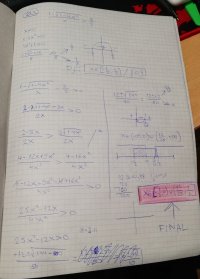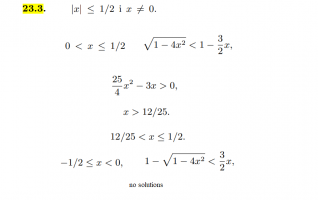Where did the absolute come from??
- Thread starter Loki123
- Start date
lev888
Elite Member
- Joined
- Jan 16, 2018
- Messages
- 2,995
The value under the square root can't be negative. This affects the domain: in addition to x != 0, we need 1-4x^2 to be non-negative. The absolute value you are asking about is the solution of this inequality.Observe first picture to see how I attempted to solve this problem. Observe the second picture to see how the solution shows it done. Where did the absolute come from along with everything else that is not like how I thought it should be? I don't even know where I went wrong...
View attachment 29515
View attachment 29516
Edit: Just looked at your solution - you got the same result, just a different method.
Okay, thank you.The value under the square root can't be negative. This affects the domain: in addition to x != 0, we need 1-4x^2 to be non-negative. The absolute value you are asking about is the solution of this inequality.
Edit: Just looked at your solution - you got the same result, just a different method.
Where's that?I must be missing something here: for 0.5< x<0 the left hand side is negative, so how can it be > 3/2 ?
blamocur
Elite Member
- Joined
- Oct 30, 2021
- Messages
- 3,211
The first line from notebook says [imath] \frac{1-\sqrt{1-4x^2}{x} > \frac{3}{2}[/imath]. When [imath]x[/imath] is negative the whole left hand side is negative too. (For some reason the math in this reply did not typeset correctly, no clue why).Where's that?
blamocur
Elite Member
- Joined
- Oct 30, 2021
- Messages
- 3,211
And in your notes you seem to have multiplied both sides by x, which only preserves inequalities when x is positive.The first line from notebook says [imath] \frac{1-\sqrt{1-4x^2}{x} > \frac{3}{2}[/imath]. When [imath]x[/imath] is negative the whole left hand side is negative too. (For some reason the math in this reply did not typeset correctly, no clue why).
I didn't multiple anything by x.And in your notes you seem to have multiplied both sides by x, which only preserves inequalities when x is positive.
blamocur
Elite Member
- Joined
- Oct 30, 2021
- Messages
- 3,211
You had to multiply by x to get from x1−1−4x2>23 to 1−4x2<1−23xI didn't multiple anything by x.
It did not render because it is in error. You need to enclose the radical in a closing curly bracket and then enclose the numerator in a second closing curly bracket. You had only one.The first line from notebook says [imath] \frac{1-\sqrt{1-4x^2}{x} > \frac{3}{2}[/imath]. When [imath]x[/imath] is negative the whole left hand side is negative too. (For some reason the math in this reply did not typeset correctly, no clue why).
You can use the preview button to identify mistakes in LaTeX. Errors will not render properly or (in most cases) at all.
No. I don’t think you did multiply by x. Rather you multiplied by 4x^2, which entailed multiplying by a positive number. But earlier you squared fractions, which raises the same issue in an even more complex way.I didn't multiple anything by x.
You attacked the problem in an unnecessarily complex way.
You started off well by thinking about the domain issues and got x=0.
Now you could have simplified your life with
1−4x2≥0⟹1≥4x2⟹41≥x2⟹
41≥x2⟹∣∣∣∣∣21∣∣∣∣∣≥∣x∣.
Putting those two together, you end up with
−21≤x<0 or 0<x≤21.
This just indicates the domain. We still have to deal with the inequality under two different cases. Now multiplying by 2x to clear fractions is the simplest approach.
0<x≤21 and x1−1−4x2⟹2−21−4x2>3x⟹
2−3x>21−4x2≥0⟹4−12x+9x2>4−16x2⟹25x2>12x
But x is positive by hypothesis.
25x>12⟹2512<x≤21.
And then you solve the case where x is negative.
Nothing wrong in how you did the problem. Correct answers do not care how you find them. But you will make fewer errors with a simpler approach.
Steven G
Elite Member
- Joined
- Dec 30, 2014
- Messages
- 14,591
Think again.I didn't multiple anything by x.


